
The Trans-Siberian Railway is without doubt, the world’s most famous train-based travel adventure on the planet. Through our Trans-Siberian Travels we learnt so much about how to plan a trip on the Trans-Siberian, but also how to pack and organise the practicalities too. Let us guide you through how to plan a trip on the Trans-Siberian Railway including our top tips for the Trans-Siberian.
You can see all our blog posts about our Trans-Siberian Travels here.
Contents
- A Little Trans-Siberian Railway History
- Where Does the Trans-Siberian Railway Go?
- Where Does the Trans-Siberian Railway Stop?
- What is it Like On Board the Trans-Siberian Railway
- Top Ten Tips for the Trans-Siberian
- What Should I Pack for a Trip on the Trans-Siberian Railway?
- What About Food and Drink on the Trans-Siberian Railway
- How Much Does Trip on the Trans-Siberian Railway Cost?
- How Can I Book Tickets for the Trans-Siberian Railway?
- What Visas Do I need for the Trans-Siberian Railway?
- What We Did: Our Trans-Siberian Travels
- Final Thoughts on How to Plan a Trip on the Trans-Siberian Railway
A Little Trans-Siberian Railway History
Russia is a huge country. From east to west it covers eleven time zones and 5,592 miles! Bringing railways to this vast country did not happen overnight. Tsar Alexander III began the project in 1881, which was subsequently taken over by his son Nicholas II. It took over 20 years to negotiate the permafrost of Siberia, mountains, forests and rivers. The final hurdle, conquered in 1904 was Lake Baikal. Previously, passengers had to catch a ferry across this expansive body of water. In 1904, the track that runs around its southern end was completed.
Finally, Moscow was fully connected to Vladivostok by 5,772 miles of railway track. This gargantuan country, spanning the entire continent of Asia, could now be covered in around four weeks. Over 100 years later, and it now takes about a week from end to end.
Where Does the Trans-Siberian Railway Go?
The Trans-Siberian isn’t one journey, but three:
Trans-Siberian – Moscow to Vladivostok
This is the classic route. It takes you from one end of Russia to the other….almost. From the lollipop-topped cathedrals of Moscow to the grey waters of Vladivostok’s port, it covers the entire length of Siberia. If you are a purest, this is the option for you.
Trans-Mongolian – Moscow to Beijing via Mongolia
This is the most popular route and what many people think of as the Trans-Siberian. It takes a turn at Ulan-Ude, travelling southeast through Mongolia and ending up in Beijing. This allows the traveller to experience three amazing countries and feel Europe slowly dissolving into Asia.
Trans-Manchurian – Moscow to Beijing via Northern China
This is the most unusual choice, and the one we decided upon. It skips Mongolia, and instead skirts around Mongolia’s northern border and travels through northeastern China. This is great if you plan to visit the Harbin ice festival but we think the other two would be better in the warmer months.
A Quick Note
All of these can be taken in either direction, but there are a couple of things to consider when making a plan a Trip on the Trans-Siberian:
- Travelling towards Moscow you will meet many more locals aboard the train. Heading east, there are a few more travellers/tourists.
- Travelling during winter, the train is less busy and less expensive which is great for the wallet but not so much fun if you want to meet new travel buddies.
Where Does the Trans-Siberian Railway Stop?
That is totally up to you. There are a million different variations to try but there is no doubt that some point you’ll be stopping in, or starting in, Moscow. We would highly recommend spending a couple of days in Russia’s fascinating capital. Irkutsk/Lake Baikal is a wonderful stop. It’s lovely to see such an expanse of water after days of hills/forest/towns. To find your other stops, we would recommend getting hold of a guidebook. We used Lonely Planet’s Trans-Siberian guidebook but Trailblazer’s Trans-Siberian Handbook also has glowing reviews.
What is it Like On Board the Trans-Siberian Railway
This is a big question, and so we have tried to break it down a little, starting with the different classes offered abroad the Trans-Siberian trains in Russia.
First Class – Spalny Vagon (SV)
With just two people to a cabin, this is the most comfortable way to travel on the Trans-Siberian (on it’s normal trains anyway).
It is very nice to have your own space if you are travelling as a twosome, especially as you can lock the door of your compartment if you go to the bathroom or dining car. Speaking of bathrooms, yours is a level above, having both hot and cold taps. Some trains even have showers in their first class carriages!
I can see the appeal of this class for the comfort and privacy, but it seems to shame to miss out on the social aspect of the journey.
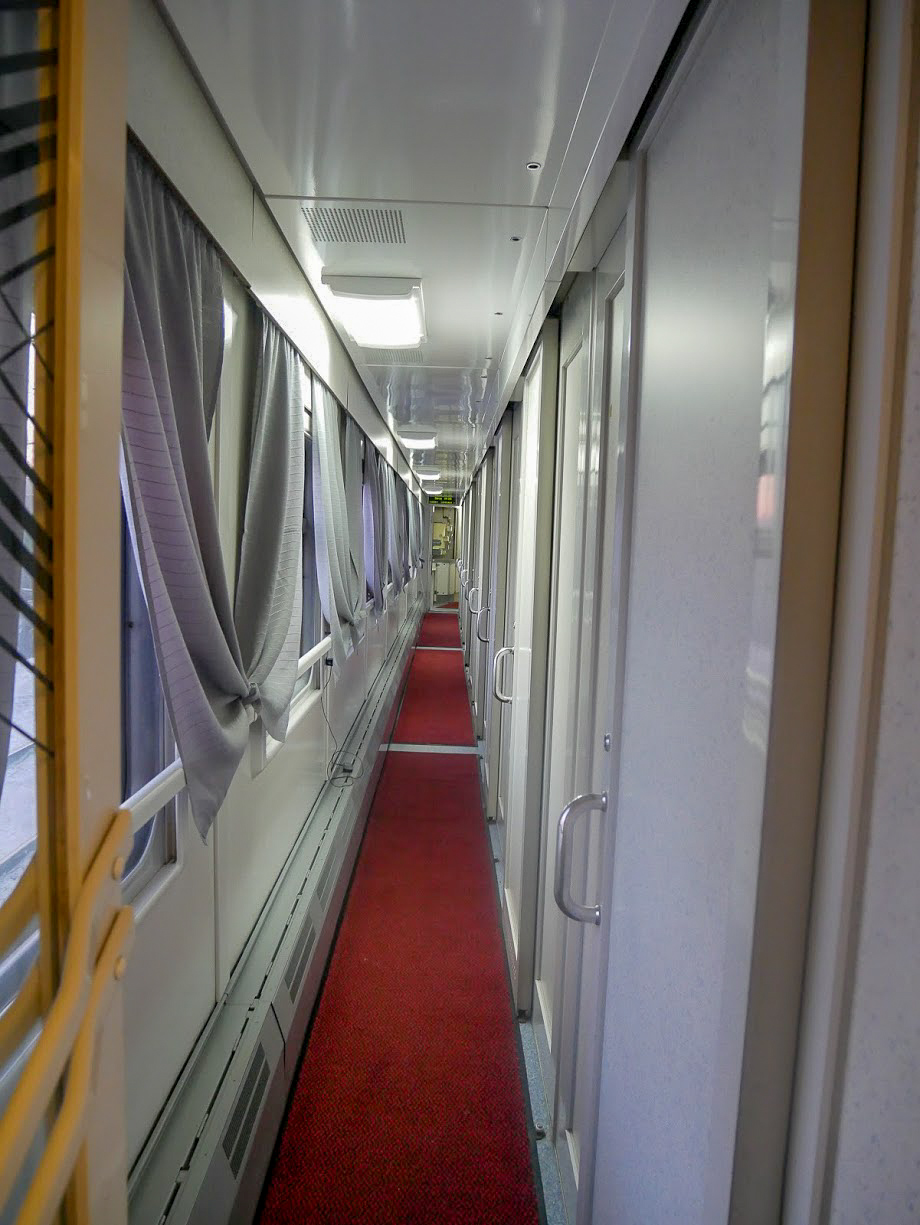
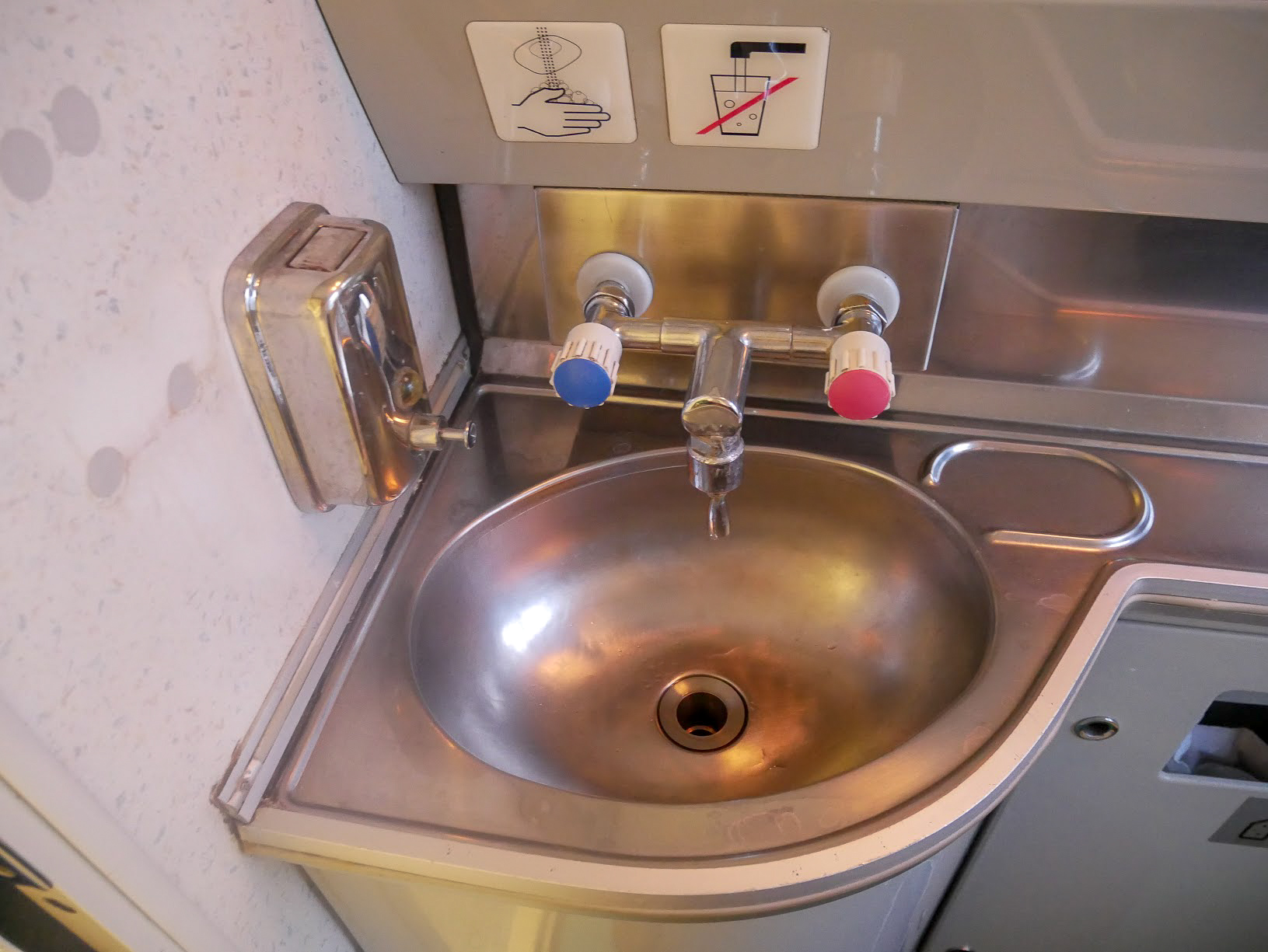
Second Class – Kupe
In second class, you have four bunks to a compartment. These are lockable and people tend to do so overnight. When booking tickets, you can choose your bunk. (Travelling as a couple, we take one upper and one lower, ensuring we can claim one whole side of the cabin, sharing the lower bunk during the day for our seats).
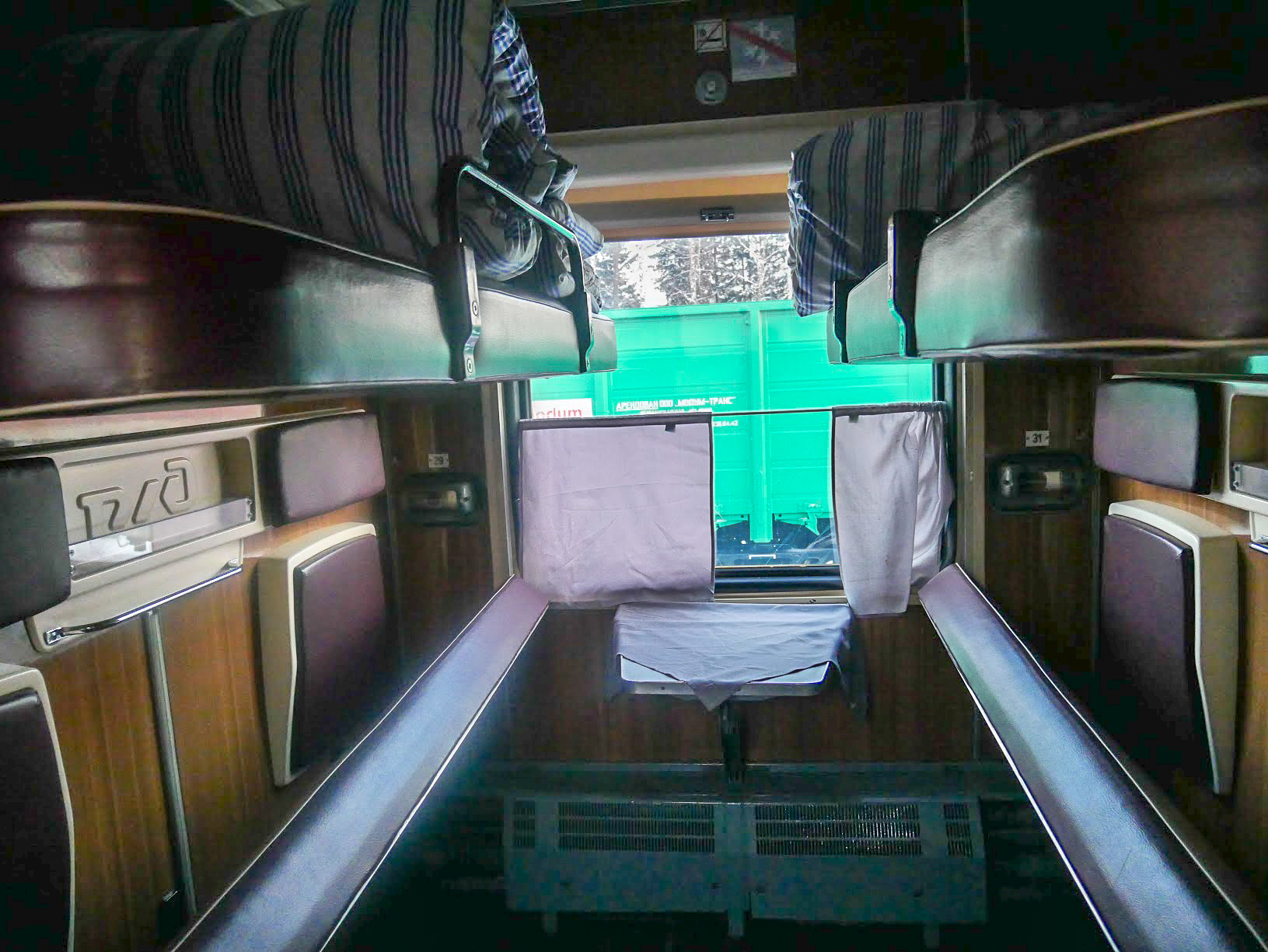
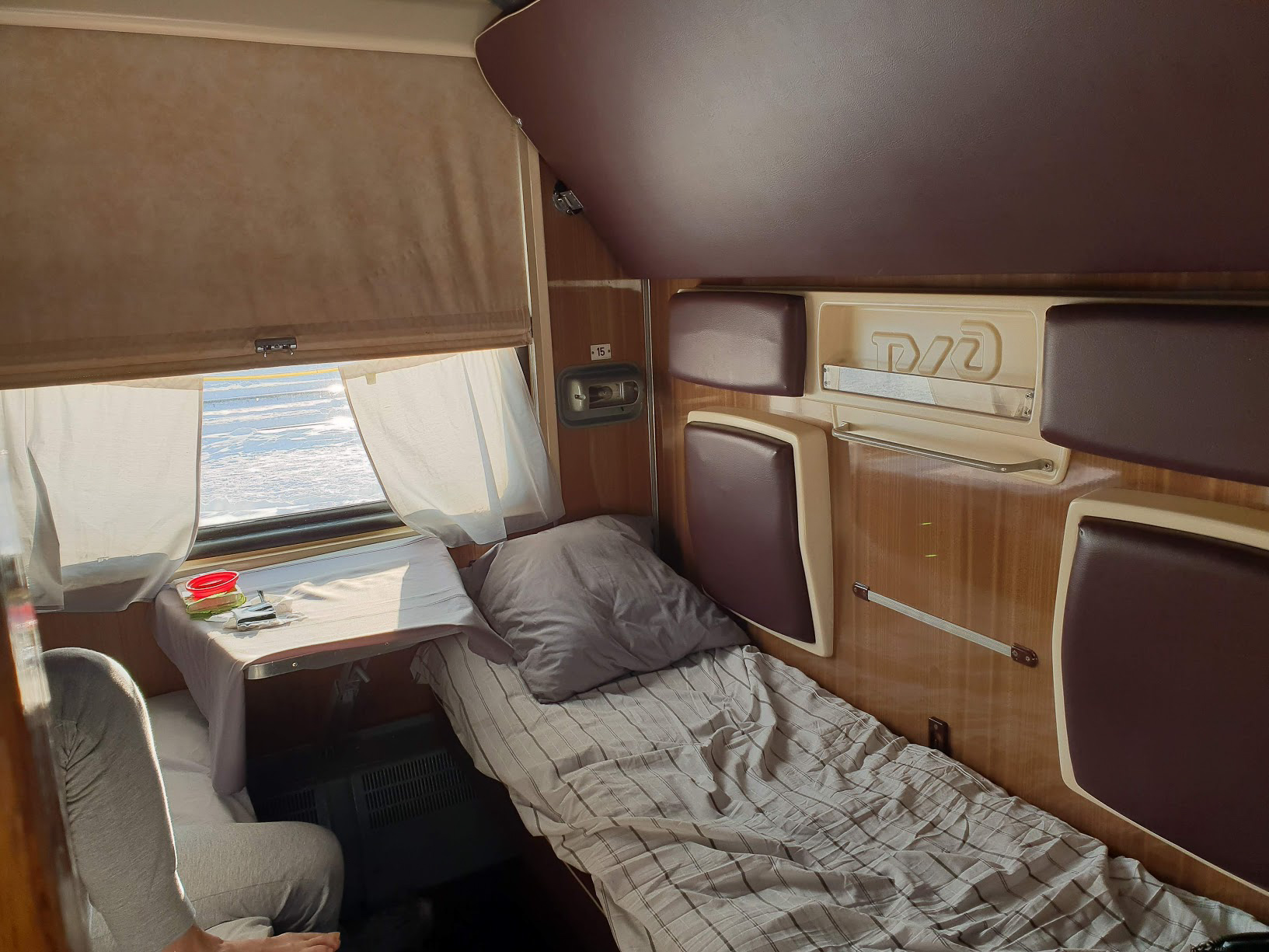
There is a box below the bottom bunk for your luggage, and a big shelf above the corridor for even more space. This matters a little more when you are sharing with strangers as you can’t leave things lying around and getting in their way.
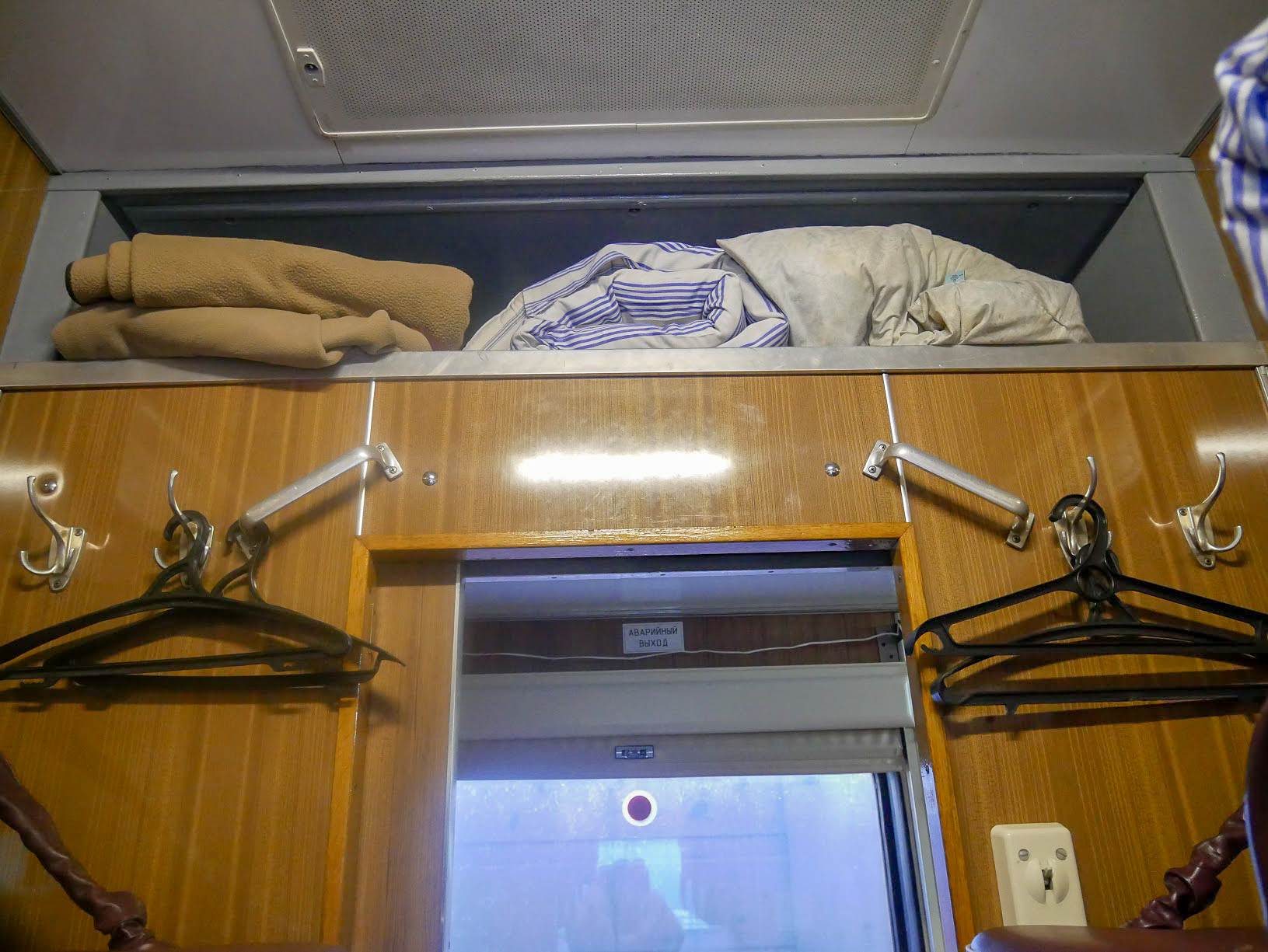

Third Class – Platskartny
Here the carriages are more open plan. There are four bunks that run perpendicular to the tracks on one side of the train, and two that are parallel on the other. This is the most sociable and economical way to travel but the bathrooms can get a little too much use, and sleep can be hard to come by with so many people around you.
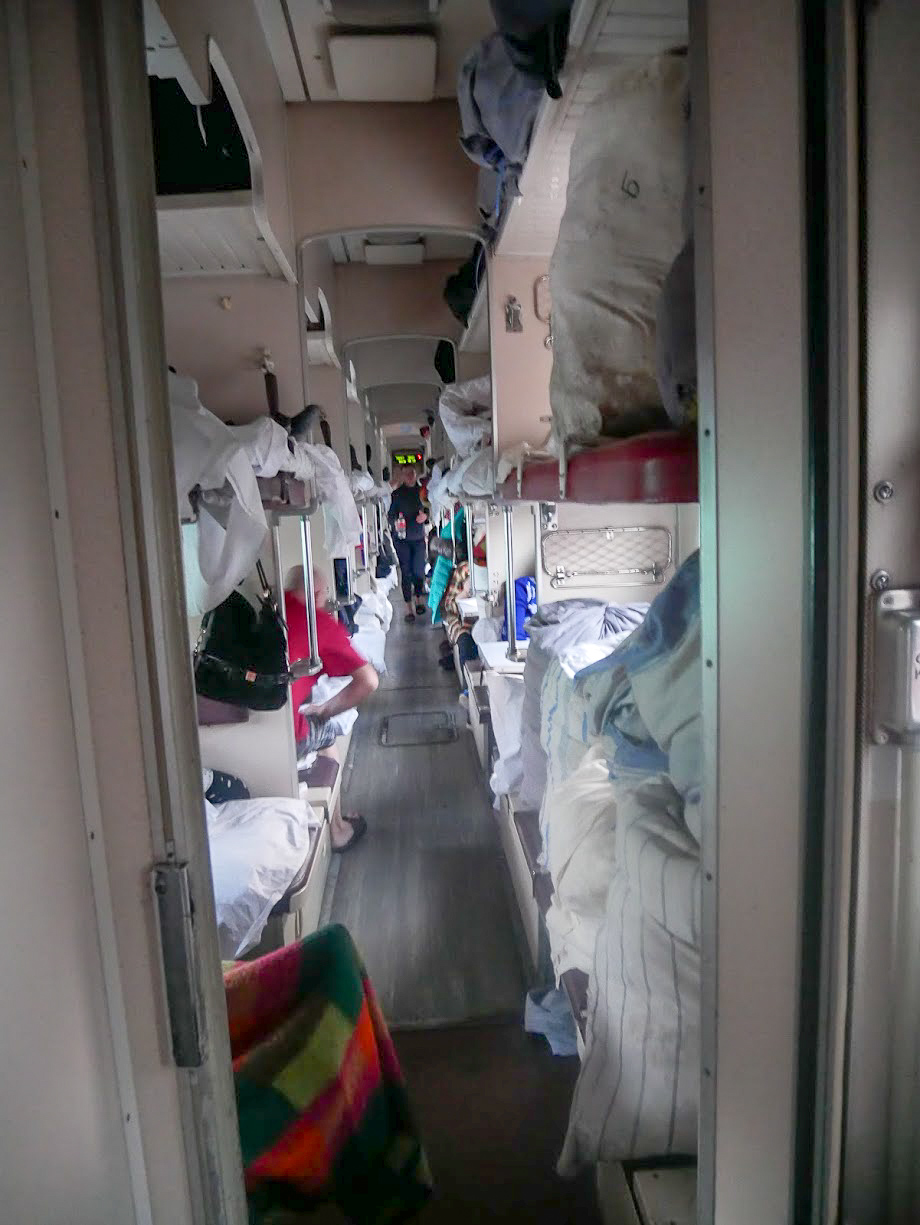
The Luxury Trains
For those looking to splash some serious cash on this once-in-a-lifetime experience, there are three luxury trains that do the journey in serious style. Sadly, we haven’t had the chance to try these out for ourselves, but have done a similar trip elsewhere (on South Africa’s Blue Train) and can attest to the magic of luxury train travel!
To see more about them, check out the websites for:
Top Ten Tips for the Trans-Siberian
Tip One – Bring Multi Plugs on the Trans-Siberian
Plugs are a rare treat on the train, some carriages have three per carriage. That’s one plug for every twelve passengers! Bare that in mind when you plan a trip on the Trans-Siberian.
We suggest bringing a multi plug that can shared by fellow travellers (that means, with local plug sockets). They will thank you for it!
Tip Two – Make friends with Your Provodnitsa/Provodnik
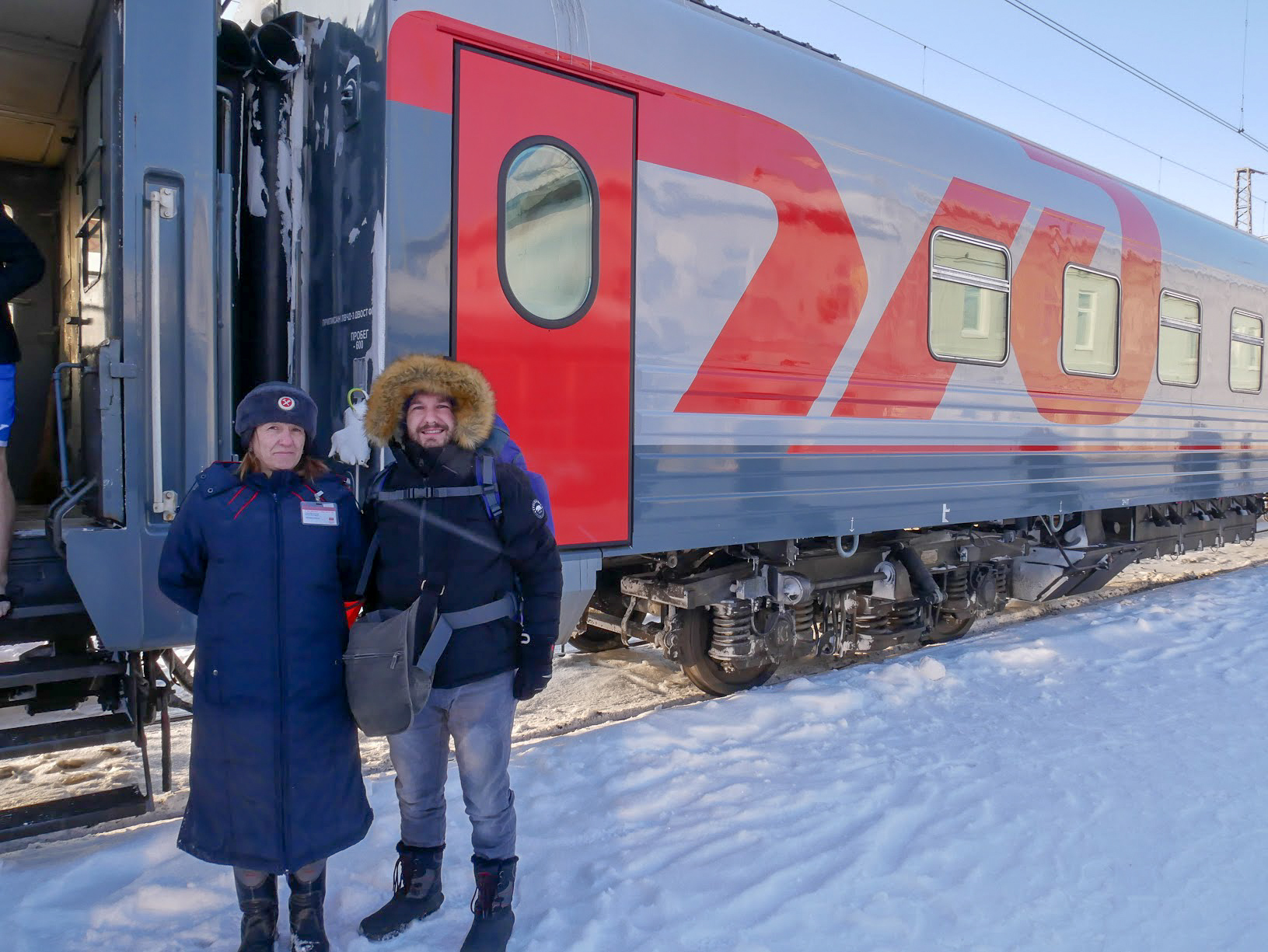
Every wagon is looked after by a conductor in a spiffing blue suit. These Provodnitsa (female) or Provodnik (male) are more often than not, women who perform plenty of duties. They keep the train wheels ice free, lug linen, run a little shop and play mother/psychologist/teacher/policeman to the passengers.Your conductor will check your tickets as you board the train. After it departs, they will come and take your ticket, swapping it for your bed linen. If you need anything, these lovely guards are your first port of call. They sleep in a small cabin at the front of each carriage. From here they sell small sachets of tea and coffee, as well as the ubiquitous herb tea that keeps many passengers ticking over. It is worth endearing yourself to your Provodnitsa. If you need any help, you’ll want a friend.
Tip Three – Feeling Steamy at the Samovar

Also at the end of every carriage is a hot water tank called a samovar. This provides boiling water day and night. It’s great for hot water bottles, instant noodles and hot drinks.
Tip Four – Google Translate is Your Friend
There are lists that suggest using a phrasebook but we are tech nerds and find that being able to say more than stock phrases is useful when you are away.
Before you leave, download both the Russian language pack, and the Cyrillic keyboard (plus, Chinese and Mongolian if required for your chosen route). It will allow you to have conversations with people and actually understand the reply, something we have rarely managed with a phrase book.
Tip Five – Pack Light Layers
You’d be amazed at just how warm some trains can become in the cabins, even in the depths of the Siberian winter. One train we caught was a toasty 25°C and all we had were thermal base layers. Bringing some much lighter layers (shorts, t-shirts) may seem counter intuitive but they may come in useful.
This tip also applies to your footwear if you are travelling in winter. Dragging on heavy winter boots every time you want to pop along the corridor to the conductor’s cabin/bathroom/dining car is a real pain. This is especially true in the tight space you have to get changed/put shoes on. Bringing some lightweight, slip on shoes will make life much easier when you plan a trip on the Trans-Siberian.
Tip Six – Carry Cash
There is no way to pay card when using the on board dining car. It is also handy if you are diving off at a stop to grab a snack from the platform hawkers.
Tip Seven – Sharing is Caring
Bring snacks/drinks that can be shared with your fellow passengers. It is good for moral, to start conversation and to make friends. If nobody wants what you’ve got…well, it’s just more for you.
Tip Eight – Check the Printed Timetable for Stops
In each carriage, a printed timetable will detail every stop with the time the train is due to arrive and leave that destination. This may seem obvious, but unlike a normal stopping train, you can be at these stops for up to 40 minutes. This is so the guards can clear ice from the wheels, refill water supplies etc etc.
So why do you need to know when this will happen? For three very good reasons:
- If you fancy popping out onto the platform from for a smoke, or some fresh air, you’ll want to know how long you’ve got.
- The toilets are locked during all station stops, and for about 20 minutes before and after each station. Toilets on board the Trans-Siberian discharge straight onto the tracks so you can see why. We just don’t want you to get caught short needing a wee during a long stop. The stop plus the extra time could mean the loo is out of action for well over an hour!
- It is always good to make sure you are getting off at the right place. Compare the schedule with the actual running time of the train. This will prevent you jumping out at the correct time, only to discover the train was running half an hour late, and you are a stop early.

Tip Nine – Travel Overnight to Save Money
A classic backpacking tip! For every night you spend on the train, you are saving the price of a hotel room.
There is a balance to strike though. There are some pretty stretches that it would be a shame to miss (like Lake Baikal) so try and catch these in daylight hours.
Tip Ten – Beware Hangovers

There is a cheap Champansky and vodka proffered by fellow travellers, but just think about how dreadful a hangover would be on the train. The toilets are often occupied by other people, they are rather chilly in winter, and the rest of the train can be very hot and humid. Jumping down from an upper bunk isn’t easy even when you are totally sober and feeling fine. Plus, the whole thing sways the entire time. Just don’t do it.
What Should I Pack for a Trip on the Trans-Siberian Railway?
As well as the couple of packing tips in that top ten tips for the Trans-Siberian, we have written a whole blog post about packing for the Trans-Siberian Railway in winter here.
What About Food and Drink on the Trans-Siberian Railway
There are two options to consider for eating when you plan a trip on the Trans-Siberian.
The Dining Car on the Trans-Siberian Railway
Every train has a dining car and they are open to everyone. The food is cheap and reasonably cheery. The service is less cheery. On our trips to the dining car, service was somewhere between brusque and agreeable….pleasantly blunt.

The food on the menu is mixture of Russian classics and simple international dishes. You’ll find chips, sandwiches, borscht, salads and meaty main dishes. It isn’t horribly overpriced as you may expect it to be. However, it really is simple and don’t expect any exciting little extras. You will get EXACTLY what it says on the menu.

Bring Your Own Food on the Trans-Siberian Railway
Whether you fancy living off Pringles for a few days, love to munch through packs of Digestives or nibble on Skittles all day, you can bring them all on board with you.
To cook proper meals, your best friend is the samovar, found in every carriage. If you bring dried noodles, rice or other exciting dried goods that are brought to life by boiling water, then you can coo your own dinner. This is considerably cheaper than eating in the dining car. We made sure to find options with a little veg in as well as the carbs and flavourings. If you want to make sure you are getting nutrients, consider bringing peelable fruit like satsumas with you too.
You can bring perishables aboard but it can be very warm in your cabin so things won’t last that long. Stinky cheese, fresh meat and fish may be less appealing on day two or three and downright dangerous on day four.
How Much Does Trip on the Trans-Siberian Railway Cost?
This is another very tricky and wide ranging question. An average journey, travelling in second class is likely to cost somewhere between £200 – £350, but this can be reduced or increased depending on how you plan a trip on the Trans-Siberian. Your class of travel, how many stops you plan to make and the trains you pick all affect the price.
The cheapest option is to roll from Moscow to Vladivostok, for seven days straight, in third class. To save the most, you need to travel in the winter months, on a top bunk, near the bathroom and on an older train. This can cost as little £80 with an additional £30 to upgrade to second class and a further £30 for a bottom bunk. You will pay additional costs for a fancier, newer train.
To travel the whole way in first class, you are looking at around £437.
The most expensive option is obviously the luxury trains as they include fine accommodations, food and drink and excursions.
How Can I Book Tickets for the Trans-Siberian Railway?
There are plenty of tour operators out there that will charge you a hefty commission to organise your journey for you. However, by creating and booking your own itinerary you will benefit from three things:
- Choice – You can plan your own itinerary according to your own interests.
- Saving Money – Paying net cost for your tickets rather than paying someone else’s commission is more often than not, the cheaper way to go.
- Social – This gives you the chance to meet all kinds of new people and not just the few on your tour.
Instead, of booking through someone else, we think you could and should create your own trip! For inspiration and more information, we suggest starting with the Man in Seat 61 website. This is our go-to starting point for when you plan a trip on the Trans-Siberian, indeed every train-based adventure we want to try.
RUSSIA
You can buy your tickets easily online using the English version of the Russian Railways website. Using this website, you can pick not only the time of train that you would like, but also the wagon and even the berth that you want. Use the price as a guide. The cheaper and slower the train, the older the carriages are likely to be.
This website CANNOT book tickets for trains that leave Russia and enter Mongolia or China.
CHINA
Booking your own tickets is impossible (welcome to your taste of being a foreigner in China). We recommend getting your tickets through the China Highlights website. They will purchase your tickets when they become available and charge a flat booking cost of around $6 for each ticket.

MONGOLIA
Again, it is possible to book these tickets through the China Highlights website. It is worth noting that the booking charge is much heftier for these at around $30 per ticket.
There are also two agencies in Mongolia that are reasonable options: www.traintomongolia.com or www.mongoliatraintickets.com</a
What Visas Do I need for the Trans-Siberian Railway?
For most travellers coming from the UK, USA, Australasia and Europe, visas are required for all three Trans-Siberian countries. This means leaving enough time and budget for your visas for China, Mongolia and Russia (depending on the route you choose).
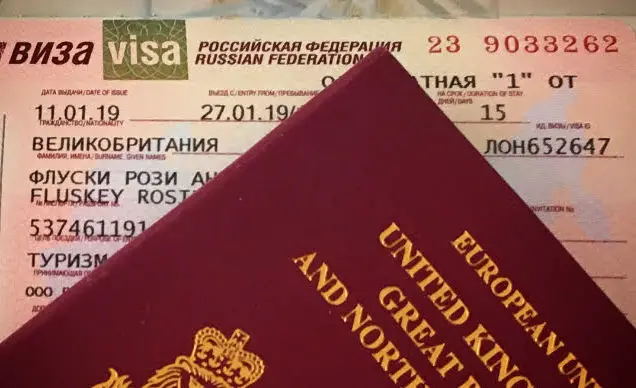
When you plan a trip on the Trans-Siberian, we have written a post all about the Real Russia visa service here. This agency will make applying for your visas quite a lot simpler and we thought they did a brilliant job.
What We Did: Our Trans-Siberian Travels
Our whole trip stemmed from our desire to visit Harbin’s world famous snow and ice festival. We knew we could catch the train from Shanghai, up to Harbin, and this sparked the idea of maybe continuing west by train. The Trans-Manchuria Railway did just that and so the trip unfolded.
You can see all our blog posts about our Trans-Siberian Travels here.
We relished the chance to meet lots of locals and indeed, travelling from east to west, in the depths of January’s deep freeze, we encountered not a single other tourist. (It didn’t hurt that the trains were cheaper doing it in winter too).
From Shanghai to St Petersburg, we did the journey in seven legs stopping along the way to see:
- Shanghai
- Beijing
- Harbin
- Ulan-Ude
- Irkutsk
- Perm
- Moscow
- St Petersburg
It truly was an adventure, one that has been rather hard to describe to other people. We think you should try it for yourselves!
Final Thoughts on How to Plan a Trip on the Trans-Siberian Railway
I don’t know if you are anything like me, but planning and (almost) pulling off our Trans-Siberian Travels independently felt like a huge achievement. I was amazed at just how easy it was to book the Russian trains, and how quickly we picked up the Cyrillic bits and bobs we needed to know to find our trains in the stations.

It can be a lovely luxury to have these things planned for one but with such an adventure we believe planning it is half of the fun!
Using this information you can plan a trip on the Trans-Siberian; we hope you have an amazing time both planning and travelling on the Trans-Siberian. If you do go, we would love to hear about your adventure so leave us a comment below or send us a message to tell us all about it!
Rosie xx



Such a helpful post. Would love to take a trip on this sometime!
Thank you so much for taking the time to let us know. It is definitely a trip to remember 🙂